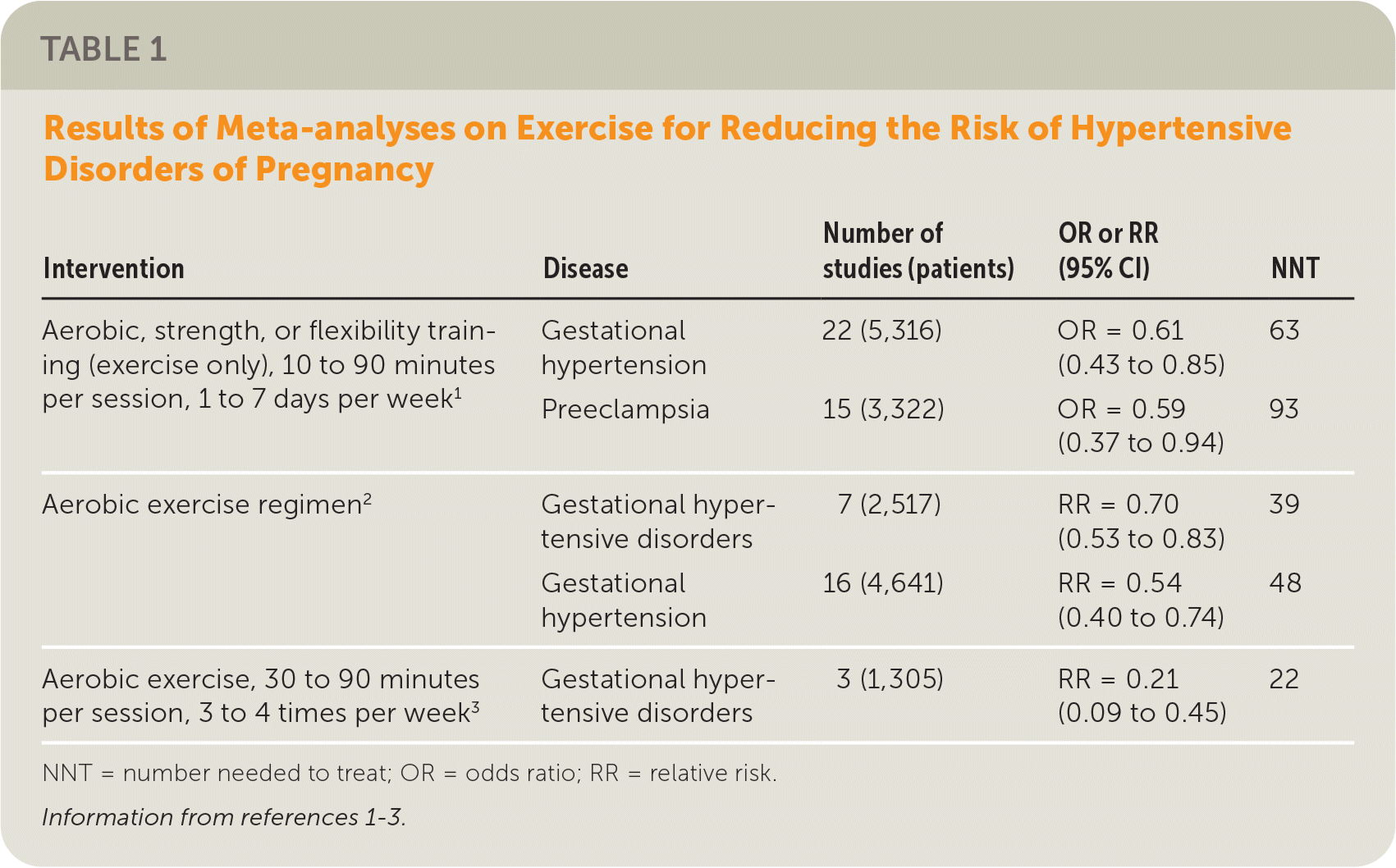
Am Fam Physician. 2022;106(1):87-88
Author disclosure: No relevant financial relationships.
Clinical Question
Does exercise during pregnancy decrease the risk of developing hypertensive disorders of pregnancy?
Evidence-Based Answer
Exercise regimens initiated early in pregnancy and performed consistently are an effective way to reduce a patient’s risk of developing gestational hypertension and preeclampsia. (Strength of Recommendation [SOR]: A, meta-analysis of randomized controlled trials [RCTs].) Aerobic exercise regimens initiated early in pregnancy and performed for at least 30 minutes three to four times per week reduce a patient’s risk of developing hypertensive disorders of pregnancy. (SOR: A, meta-analysis of RCTs.)
Evidence Summary
A 2018 systematic review and meta-analysis that included 106 unique RCTs and 273,182 pregnant patients analyzed the protective effect of exercise on preventing gestational hypertension and preeclampsia during pregnancy.1 A pooled estimate from 22 of the RCTs with exercise-only interventions included in the meta-analysis (n = 5,316) found a 39% reduction in the odds of developing gestational hypertension (number needed to treat [NNT] = 63; Table 11–3). Another pooled estimate from 15 of the RCTs (n = 3,322) showed 41% lower odds of developing preeclampsia in the exercise-only intervention group vs. control groups that did not exercise (NNT = 93). A meta-regression analysis suggested that as little as 25 minutes of exercise three days per week could provide the above benefits.

| Intervention | Disease | Number of studies (patients) | OR or RR (95% CI) | NNT |
|---|---|---|---|---|
| Aerobic, strength, or flexibility training (exercise only), 10 to 90 minutes per session, 1 to 7 days per week1 | Gestational hypertension Preeclampsia | 22 (5,316) 15 (3,322) | OR = 0.61 (0.43 to 0.85) OR = 0.59 (0.37 to 0.94) | 63 93 |
| Aerobic exercise regimen2 | Gestational hypertensive disorders Gestational hypertension | 7 (2,517) 16 (4,641) | RR = 0.70 (0.53 to 0.83) RR = 0.54 (0.40 to 0.74) | 39 48 |
| Aerobic exercise, 30 to 90 minutes per session, 3 to 4 times per week3 | Gestational hypertensive disorders | 3 (1,305) | RR = 0.21 (0.09 to 0.45) | 22 |
A 2017 systematic review and meta-analysis of 17 RCTs (N = 5,075) from the United States and Europe evaluated the effect of aerobic exercise interventions on gestational hypertensive disorders, defined as gestational hypertension or preeclampsia.2 Pregnant patients who engaged in an average of 30 to 60 minutes of aerobic exercise two to seven times per week (starting early in pregnancy through 35 weeks’ gestation) were found to have a 30% lower risk of gestational hypertensive disorders (NNT = 39; seven studies; n = 2,517) and a 46% lower risk of gestational hypertension (NNT = 48; 16 studies; n = 4,641). Subgroup analyses comparing trials of only aerobic exercise vs. no aerobic exercise found significantly lower risk of gestational hypertensive disorders (relative risk [RR] = 0.39; 95% CI, 0.20 to 0.73).
A 2016 systematic review and meta-analysis of 2,059 patients in the United States determined that exercise during pregnancy does not impact preterm birth rates (4.5% vs. 4.4% in the control group; RR = 1.01; 95% CI, 0.68 to 1.50).3 A secondary outcome showed that the exercise group had a significantly lower incidence of gestational hypertensive disorders compared with the control group (1.0% vs. 5.6%; RR = 0.21; NNT = 22). Data on gestational hypertensive disorder outcomes were reported by only three of the nine RCTs, which included a total of 1,305 sedentary pregnant patients who were randomized to exercise vs. no exercise before 23 weeks’ gestation. The exercise group engaged in 30 to 90 minutes of aerobic exercise three or four times weekly for 10 weeks.
Recommendations From Others
In 2020, the American College of Obstetricians and Gynecologists updated their committee opinion on exercise during pregnancy.4 The committee opinion states: “Physical activity and exercise in pregnancy are associated with minimal risks and have been shown to benefit most women, although some modification to exercise routines may be necessary because of normal anatomic and physiologic changes and fetal requirements.” It also notes that “additional research is needed to study the effects of exercise on pregnancy-specific conditions and outcomes and to clarify further … the optimal type, frequency, and intensity of exercise.”4
